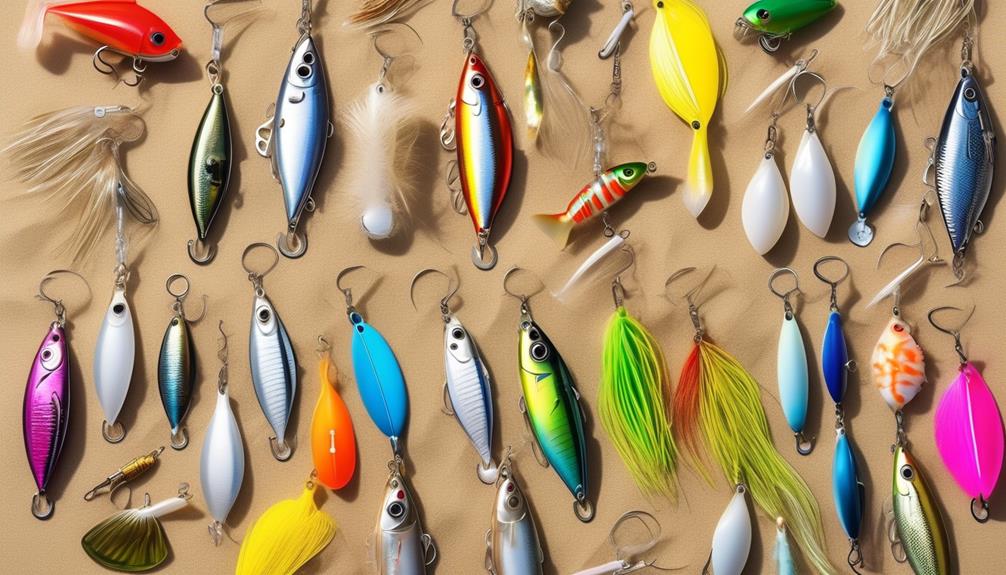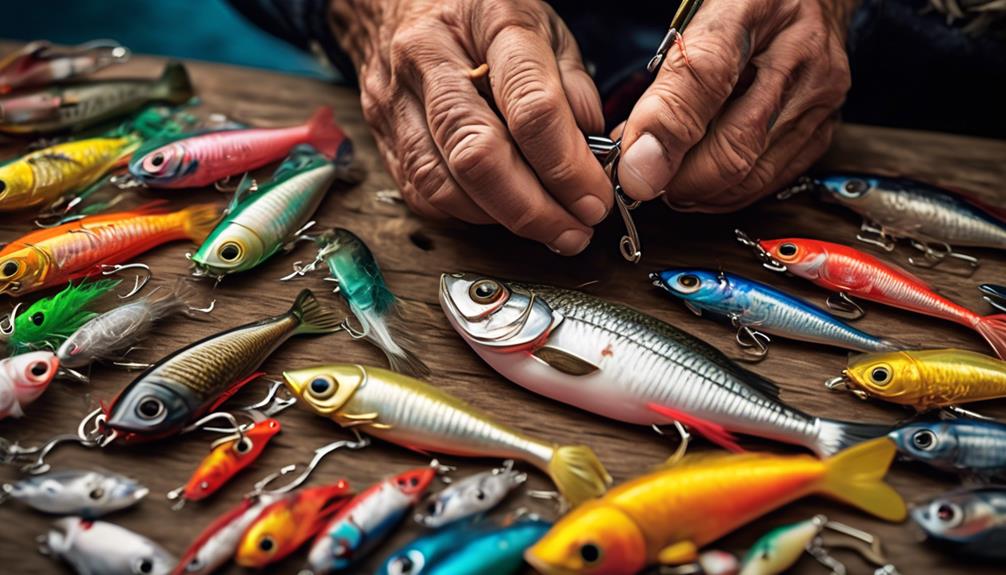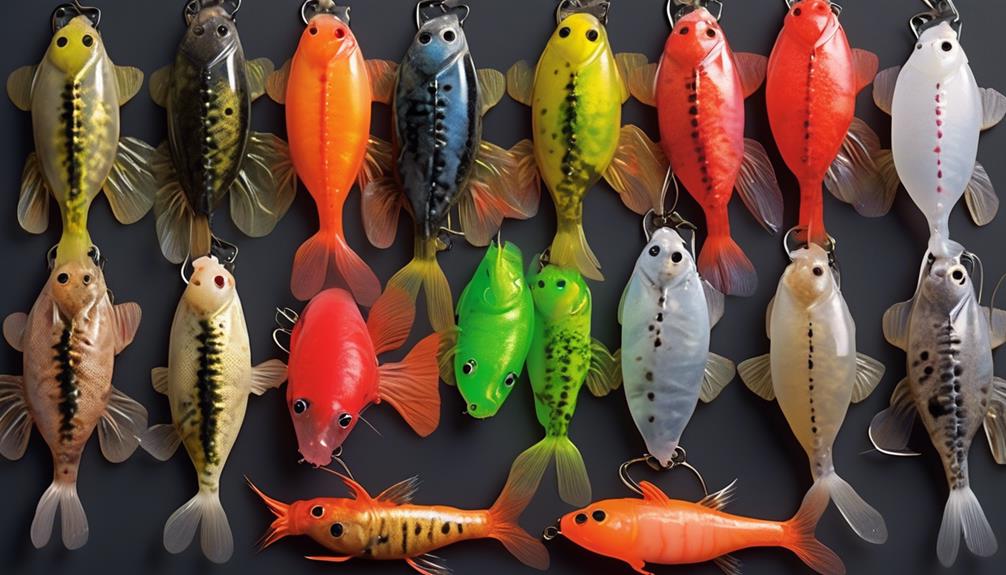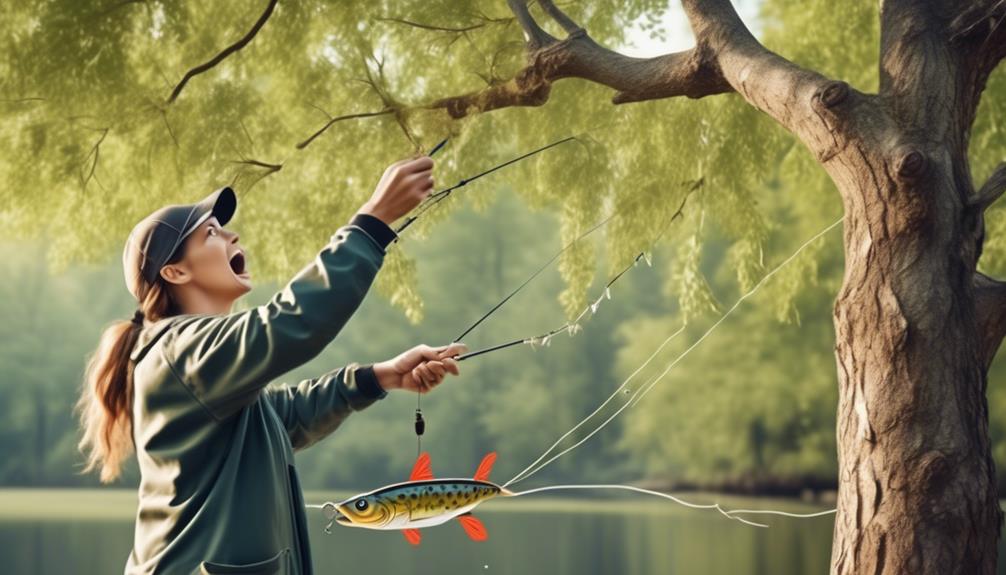If you're a saltwater angler on a budget, finding the right fishing lure can be like searching for a needle in a haystack. But fear not, as there are plenty of affordable options that can help you hook that elusive catch without breaking the bank.
From topwater poppers to soft plastic swimbaits, the market is filled with budget-friendly saltwater fishing lures that can help you reel in the big ones. But which ones are truly worth your investment?
Stay tuned to discover the top picks that will elevate your saltwater fishing game without draining your wallet.
Topwater Poppers
When targeting aggressive saltwater species, using topwater poppers can entice explosive strikes and create an exhilarating angling experience. To maximize your success with these lures, it's essential to master popper techniques and know the best locations to use them.
When working a popper, use short, sharp twitches with your rod tip to create a splashing and popping action that mimics a distressed baitfish. This erratic movement often triggers aggressive strikes from predatory fish like striped bass, bluefish, and trevally.
It's crucial to focus on areas with active baitfish, such as rocky shorelines, jetties, and estuary entrances, as these are prime locations for using topwater poppers.
To ensure that your topwater poppers remain in optimal condition, proper maintenance and storage are essential. After each fishing trip, rinse your poppers with freshwater to remove salt and any debris. Check the hooks for any signs of rust or damage, and replace them if necessary to maintain their effectiveness.
When storing your poppers, it's best to keep them in individual compartments within a tackle box to prevent tangling and damage to their paint and finish. Additionally, storing them in a cool, dry place away from direct sunlight can help prolong their lifespan and keep them ready for your next saltwater angling adventure.
Soft Plastic Swimbaits
Soft Plastic Swimbaits offer versatile and realistic options for enticing saltwater fish. These lures come in a variety of sizes and designs, making them a go-to choice for many anglers looking to target a wide range of saltwater species.
One of the key advantages of soft plastic swimbaits is their ability to be rigged with weighted hooks, allowing for varied presentations depending on the fishing conditions. When it comes to fishing in saltwater, the use of weighted hooks with soft plastic swimbaits is crucial. This setup enables you to effectively target fish at different depths, from shallow flats to deeper waters. The weighted hooks provide the necessary casting distance and help the swimbait sink to the desired level, making them suitable for a range of fishing environments.
In addition to their versatility, soft plastic swimbaits come in an array of color options. This variety allows you to choose the most suitable color patterns based on the prevailing conditions and the specific species you're targeting. Whether it's a natural baitfish imitation or a vibrant, attention-grabbing color, having multiple color options in your tackle box can greatly increase your chances of success.
Jigs and Bucktail Jigs
Jigs and bucktail jigs are highly effective saltwater fishing lures, offering anglers versatile options for targeting a variety of coastal and offshore species. When it comes to jigging techniques, it's essential to vary your retrieval speed and depth to entice different fish species. Experiment with a steady retrieve, erratic jerking motions, or a stop-and-go approach to see what triggers the most strikes.
Bucktail jig variations, such as those with holographic or glow finishes, can add an extra element of attraction, especially in murky or deep waters.
For the best jigging locations, look for underwater structures like reefs, wrecks, and rock piles. These areas are prime spots for predatory fish to ambush their prey. Additionally, jigging near drop-offs and ledges can yield impressive results.
When it comes to jigging in different weather conditions, overcast days are particularly favorable. The reduced light penetration can make fish more willing to strike at lures. Conversely, on bright, sunny days, focusing on deeper waters or seeking out shaded areas near structures can increase your chances of success.
Whether you're targeting flounder, striped bass, or bluefish, jigs and bucktail jigs are go-to options for saltwater anglers. By mastering various jigging techniques and selecting the right jig for the conditions, you can consistently reel in impressive catches.
Spoon Lures
Spoon lures, with their distinctive shape and enticing wobble, are a popular choice for targeting a wide range of saltwater game fish. When it comes to casting techniques, spoon lures are incredibly versatile. For long-distance casting, use a smooth, steady motion, allowing the spoon to sail through the air and cover a larger area. However, if you're targeting a specific area or structure, a shorter, more controlled cast can be effective. Keep in mind that the weight of the spoon and the strength of your line will also influence casting distance and accuracy.
As for retrieval methods, spoon lures can be worked in various ways to entice strikes. A steady, medium-paced retrieve is a classic technique that allows the spoon to flutter and flash, mimicking a wounded baitfish. This method is effective for a wide range of species, including mackerel, bluefish, and redfish. Alternatively, you can try a stop-and-go retrieve by reeling in the spoon quickly for a few cranks, then pausing to let it flutter down before repeating. This erratic movement can trigger aggressive strikes from predatory fish.
Experimenting with different retrieval speeds and pauses can help you identify what the fish are responding to on any given day. Remember to vary your techniques until you find what works best for the conditions and the behavior of the fish.
Spinnerbaits
When targeting saltwater game fish, spinnerbaits offer anglers a versatile and effective lure option. These lures are designed to mimic the movement of baitfish, making them highly attractive to predatory species in saltwater environments. Here are some key points to consider when using spinnerbaits for saltwater fishing:
- Spinnerbait Techniques, Saltwater
- Vary your retrieval speed: Experiment with different retrieval speeds to find the most effective presentation for the specific species you're targeting. Faster retrieves can mimic fleeing baitfish, while slower retrieves can entice more cautious or lethargic fish.
- Use erratic movements: Incorporate sudden jerks or pauses in your retrieve to make the spinnerbait dart and dash unpredictably, emulating the behavior of injured prey. This erratic action can trigger aggressive strikes from saltwater predators.
- Target structure and currents: Spinnerbaits excel in areas with structure such as reefs, rocks, and drop-offs. Additionally, they can be effective in areas with strong currents, as the spinning blade creates vibrations and flash that can attract fish from a distance.
- Spinnerbait Customization, Saltwater
- Swap out the skirt: Customize your spinnerbaits by replacing the standard skirt with one that closely matches the color and profile of the local baitfish. This simple modification can significantly increase the lure's effectiveness in saltwater environments.
- Upgrading hooks and hardware: Saltwater species can be powerful and aggressive, so it's essential to upgrade the hooks and hardware on your spinnerbaits to ensure they can withstand the rigors of saltwater angling.
- Adjusting blade size: Experiment with different blade sizes to find the optimal combination for the conditions you're fishing in. Larger blades can produce more flash and vibration, while smaller blades can create a subtler presentation.
Saltwater Grubs
Saltwater grubs are a versatile and highly effective lure option for anglers targeting a variety of saltwater game fish. When it comes to saltwater grub techniques and best practices, consider using a slow, steady retrieve to mimic natural bait movements. Additionally, varying retrieval speed and adding occasional twitches can entice strikes, especially when targeting species like flounder, sea trout, and redfish. These techniques are particularly effective when fishing over shallow flats or around structure where game fish commonly feed.
Grub color selection is crucial for maximizing effectiveness in different conditions. In clear water, opt for natural hues like white, pearl, or silver to mimic baitfish. In murkier conditions or low light, darker colors such as root beer, motor oil, or black with glitter can enhance visibility and attract strikes. It's also beneficial to have a variety of colors on hand to adapt to changing light and water clarity throughout the day.
When fishing with saltwater grubs, it's essential to adjust to the specific conditions and behavior of the target species. By experimenting with different retrieval speeds, depths, and colors, you can increase your chances of enticing strikes. Keep in mind that saltwater grubs can be particularly effective when fishing in areas with strong currents or when targeting fish that are feeding near the bottom. With the right techniques and color selection, saltwater grubs can be a go-to lure for a wide range of saltwater game fish.
Shrimp Imitation Lures
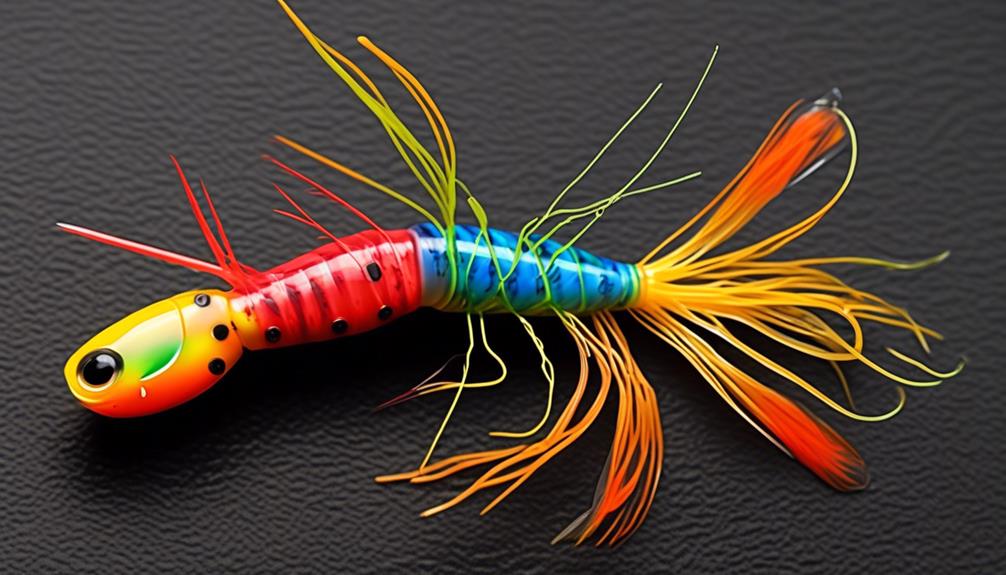
To mimic the natural movements of shrimp and attract saltwater game fish, anglers often turn to shrimp imitation lures as a versatile and effective option. Shrimp imitation lure techniques play a vital role in enticing the attention of predatory fish. Effective retrieves include a slow, steady retrieve to mimic the natural movement of shrimp, as well as intermittent twitches to simulate a distressed shrimp, triggering a predatory response from game fish.
When it comes to shrimp imitation lure color selection, anglers often debate between natural and vibrant patterns. Natural colors, such as browns and greens, aim to closely resemble the appearance of live shrimp, making them a go-to choice in clear water or when fish are feeding on more natural prey. On the other hand, vibrant patterns, like chartreuse or pink, are effective in murky or stained water, as they offer high visibility and trigger aggressive strikes from predatory fish.
- Mastering the Technique: Practice different retrieval methods such as slow and steady retrieves, accompanied by occasional twitches, to effectively imitate the movements of live shrimp.
- Natural vs. Vibrant Colors: Consider the water conditions and the behavior of the target species when choosing between natural and vibrant patterns, as this decision can significantly impact your success.
- Observation and Adaptation: Pay attention to the behavior of the fish and be prepared to adapt your technique and lure color based on the environmental factors and the fish's response.
Squid Jigs
Imitating the natural movements of shrimp has proven effective for enticing saltwater game fish, and now, let's explore another versatile lure option with squid jigs. Squid jigs are effective tools for catching saltwater game fish, particularly in areas where squid are abundant. When using squid jigs, it's important to employ the right techniques and target the best locations to maximize your chances of success.
Squid jig techniques involve imparting lifelike movements to the lure, mimicking the natural actions of a squid. This can be achieved by imparting a gentle, rhythmic jerking motion to the rod, causing the squid jig to dart and dive in a manner that attracts the attention of predatory fish. Additionally, it's crucial to focus on the best locations for squid fishing. Areas with rocky bottoms, kelp beds, and offshore reefs are often prime spots for targeting squid and, subsequently, the game fish that feed on them.
In terms of maintenance and care, keeping your squid jigs clean and well-preserved is essential for their effectiveness. After each use, rinse the jigs with freshwater to remove any salt or debris. Ensure that they're completely dry before storing them to prevent corrosion. Checking the hooks for any signs of damage and sharpening them as needed will also help maintain the jigs in top condition for your next saltwater fishing adventure.
Frequently Asked Questions
How Can I Effectively Store and Organize My Saltwater Fishing Lures to Prevent Them From Getting Tangled or Damaged?
To effectively store and organize your saltwater fishing lures, tackle boxes are essential. Utilize tackle boxes with adjustable dividers to customize storage for different lure sizes.
Separate lures by type and size to prevent tangling and damage. Utilize clear plastic containers within the tackle box for smaller lures to keep them organized and visible.
Labeling compartments can also help you quickly locate the specific lures you need while fishing.
Are There Any Specific Techniques or Tips for Using Saltwater Grubs and Shrimp Imitation Lures in Different Weather Conditions or Water Depths?
When using saltwater grubs and shrimp imitation lures, consider adapting to changing currents and tides for optimal lure presentation.
Vary casting techniques based on weather conditions and water depths. Experiment with retrieval speeds to mimic natural movements.
In deeper waters, try jigging or using weighted hooks. In shallow areas, focus on a more natural drift.
Stay adaptable and responsive to the environment for a successful fishing experience.
What Are Some Common Mistakes Anglers Make When Using Spinnerbaits, and How Can I Avoid Them?
When using spinnerbaits, common mistakes include wrong retrieval speed and not varying the depth.
Avoid these errors by adjusting your retrieval speed to match the water temperature and depth. Use a slow, steady retrieve in cold water and speed up in warmer conditions.
Vary your depth by changing your line angle and using different weight spinnerbaits.
Are There Any Specific Types of Fish That Are More Likely to Be Attracted to Squid Jigs, and What Are the Best Locations to Use Them?
When using squid jigs, certain fish species are more likely to be attracted to them. The effectiveness of squid jigs is often seen with species like squid, cuttlefish, and even some species of fish like snapper and grouper.
Best fishing locations for squid jigs are typically around rocky structures or areas with a lot of baitfish. These lures can be quite effective for targeting these species in saltwater environments.
Can I Use the Same Rod and Reel Setup for All the Different Types of Saltwater Fishing Lures, or Are There Specific Gear Recommendations for Each Type?
You can absolutely use the same rod and reel setup for all the different types of saltwater fishing lures. It's a versatile choice that can cover a wide range of fishing scenarios.
When using topwater lures, ensure your setup allows for accurate casting and smooth retrieval.
For types of trolling lures, a reliable rod and reel combo with strong line capacity is key.
Just make sure your gear is suited to the specific lure techniques you plan to use.
Conclusion
So, next time you're out on the water, don't break the bank on expensive lures.
With these budget-friendly options, you can still reel in the big catch without emptying your wallet.
Happy fishing!
